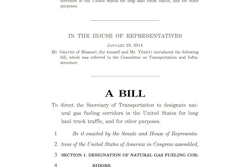Responding to criticism from some stock analysts, Clean Energy Fuels says its investment in America’s Natural Gas Highway and LNG is a smart one – and that critics have understated the company’s strong position in CNG fueling.
Recent Wall Street reports and popular financial blogs have questioned Clean Energy’s build-out of a cross-country liquefied natural gas fueling network before there are enough trucks on the road to support it.
Indeed, the company on Monday reported 115 stations have been built for ANGH, with only 22 currently open. But the company has opened six stations since December and has another 64 “ready to be open,” according to CEO Andrew J. Littlefair.
“Those stations don’t require any more capital, just a very minimal kind of commissioning and they are ready to open – that capital has been spent,” Littlefair told investment analysts on a quickly arranged conference call.
In the update on natural gas fuels for the trucking industry, Littlefair admitted that adoption of LNG for over-the-road use has been slow in coming, but that Clean Energy is nonetheless well positioned both presently, with its leading position in CNG stations, and for the future.
“I think it’s very important to understand that each market is huge: urban, regional, last mile, distribution center trucking that’s sometimes in urban settings – it’s billions of gallons. And in many cases that will be very well suited for CNG,” Littlefair said. “On the other hand, long-haul, regional, interstate sleeper cabs and those kinds of trucking, that’s billions of gallons – so the markets are both very large.”
To service the former, Clean Energy has more CNG stations “than almost all of our competitors combined,” Littlefair added, and he passed along the numbers: Clean Energy built 55 CNG stations in 2013 and now operates 317, filling 7,000 transit buses and 5,000 trash trucks every night.
But many of those stations are “behind the fence,” or dedicated, private installations in urban settings. The ANGH stations are retail oriented and located in more rural areas.
Littlefair discounted the suggestion that the LNG market is collapsing, specifically a report that 80 to 90 percent of the natural-gas trucks being ordered with the 400 h.p. Cummins Westport ISX 12G are built for CNG.
By Clean Energy’s count, 1,444 heavy-duty trucks with 12-liter natural-gas engines were delivered last year, and 58 percent were CNG compared to 42 percent LNG.
Among Clean Energy’s current customer base of 137 fleets, representing about 3,500 natural-gas trucks, the ratio is 57 percent LNG to 31 percent CNG.
(A Westport spokesman tells CCJ the company would release engine production numbers in its upcoming fourth-quarter earnings report, but neither Westport nor the truck makers contacted track natural gas engine sales or deliveries by type, the respective spokesmen say.)
He names UPS, Swift, Modern Transport, Raven Transport, Lowe’s and California Cartage Co. as current customers – with others “in the pipeline, literally hundreds of fleets that are getting with the program,” Littlefair said.
And Littlefair expects the LNG segment to continue to grow, noting that a natural-gas engine suitable for long-haul trucks didn’t come on the market until last August, well behind the delivery schedule Clean Energy had anticipated.
He also suggested that “early adopters” and fleets wishing to test natural gas trucks may have opted for CNG in limited numbers out of convenience, and will switch to LNG – but that’s contrary to some analysts’ speculation, which has LNG users switching to CNG.
“It’s probably easier and quicker to use CNG today just because there are more stations available than LNG,” Littlefair said. “But it’s one thing to test six trucks and work that into your fleet of 1,000 trucks. It’s another when you begin to take them in groups of 100 or more.”
The LNG advantages will come into play with the larger numbers of trucks, he explained. He also said that nothing precludes Clean Energy from putting in CNG stations along side LNG facilities “if and when that makes sense.”
But Littlefair argues that fast-fuel CNG stations capable of serving 100 trucks per day are much more expensive to build (2 to 2.5 times the cost of an LNG station) and are even more impractical for rural locations due to infrastructure requirements.
And the added weight of CNG tankage suitable for long haul may well offset any CNG pump price advantage.
“So when you take into consideration the time of fueling, the cost of the stations and the weight, and look at the overall lifecycle cost of the truck, we think that you begin to understand the pricing in the fuels are very competitive,” Littlefair said.
He expects some 10,000 natural gas heavy-duty trucks to be sold in 2014, a five-fold increase.
“Regardless of which way the industry goes – and it will ebb and flow, as we saw in refuse and in transit over time – CNG or LNG, we’re ready to serve our customers,” Littlefair said. “This is a big country. But we have the most coverage and we’re working with the most fleets. Nobody else has that. So I think we’ll still get a fairly nice market share of those trucks, be it CNG or LNG.”













